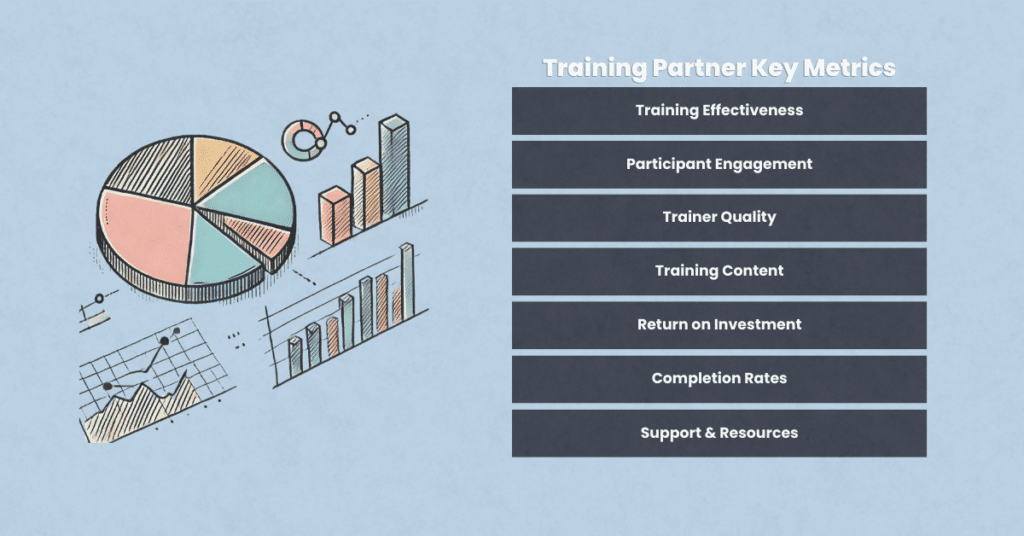Introduction
Choosing the right training partner can significantly impact your organization’s growth and success. The right partner will ensure that employees are equipped with the necessary skills to meet the company’s objectives and adapt to industry changes. How do you evaluate a training partner? Selecting one or two metrics in each of the following categories should go a long way to ensuring that your trainer is having the impact you need.
1. Training Effectiveness
Learning Outcomes:
Evaluate the extent to which training participants achieve desired learning outcomes. Training should be aligned with your organization’s goals and aim to improve the skills and knowledge needed for employees to excel in their roles. By setting clear, measurable objectives for each training session, you can determine whether the training has met its intended purpose. Look for evidence that participants have gained new skills and knowledge relevant to their work, which can be demonstrated through improved performance and problem-solving abilities.
Assessment Scores:
Implement pre- and post-training assessments to measure knowledge improvement. These assessments help quantify learning progress and offer concrete data on the effectiveness of the training. By comparing scores before and after the training, you can identify areas of improvement and pinpoint aspects of the training that may require enhancement. This data-driven approach helps ensure that the training content is impactful and provides valuable insights into participants’ learning progress.
Skill Application:
Monitor how well participants apply new skills on the job. Conduct performance evaluations and gather feedback from managers and peers to observe changes in work quality or productivity. An effective training program should lead to noticeable improvements in job performance and contribute to achieving organizational goals. Additionally, it’s beneficial to track whether the skills learned are applied consistently and effectively over time, indicating the training’s long-term impact.
2. Participant Engagement
Attendance Rates:
Track attendance to gauge participants’ commitment and interest levels. High attendance rates often indicate that employees value the training and recognize its relevance to their roles. Consistent attendance also reflects the training’s perceived quality and importance. If attendance rates are low, it may signal a lack of engagement or misalignment with employee needs and interests.
Participation Levels:
Monitor active participation through activities, discussions, and exercises. Engagement during training sessions is a strong indicator of participants’ interest and investment in the learning process. Encourage interactive sessions where participants can ask questions, share experiences, and collaborate on problem-solving exercises. Active participation fosters a dynamic learning environment and ensures that participants remain focused and motivated.
Feedback Surveys:
Collect feedback on engagement and satisfaction through surveys. These surveys should include questions about the training’s content, delivery, and overall experience. Feedback can help identify areas of improvement and provide insights into participants’ perceptions of the training. Regularly analyzing this feedback allows you to make necessary adjustments to enhance engagement and satisfaction, ultimately improving training effectiveness.
3. Trainer Quality
Expertise and Experience:
Assess the trainer’s background, qualifications, and expertise in the subject matter. Trainers should possess relevant experience and a strong understanding of the topics they are teaching. Their ability to connect theory with practical application is crucial for delivering valuable training. Evaluating trainers’ credentials and past performance can help ensure that they are well-equipped to provide high-quality instruction.
Delivery Style:
Evaluate the trainer’s ability to communicate effectively and engage participants. A trainer’s delivery style significantly impacts participants’ learning experiences and retention of information. Look for trainers who can present complex concepts in an understandable and engaging manner, using various teaching methods to accommodate different learning styles. A dynamic and interactive delivery style can enhance learning experiences and keep participants engaged throughout the session.
Feedback on Trainers:
Gather participant feedback on trainer performance. Solicit opinions on the trainer’s knowledge, delivery style, and ability to engage and motivate participants. This feedback can help identify strengths and areas needing development, allowing for continuous improvement of the training program. Use this information to ensure trainers consistently meet participants’ expectations and contribute to a positive learning environment.

4. Training Content
Relevance:
Ensure the training content aligns with organizational needs and industry standards. Training should address current challenges and opportunities in your field, providing employees with the skills needed to succeed. Regularly review and update content to maintain its relevance and effectiveness. The training should focus on skills that are directly applicable to employees’ roles and contribute to achieving strategic objectives.
Up-to-date Material:
Verify that the content includes the latest industry trends and practices. Staying current with industry developments is crucial for maintaining a competitive edge. Training materials should reflect recent advancements and innovations, preparing employees to navigate an ever-evolving business landscape. Incorporate real-world examples and case studies to demonstrate the practical application of new knowledge.
Customization:
Evaluate the training partner’s ability to tailor content to your organization’s specific requirements. Customized training addresses the unique challenges and goals of your organization, enhancing its relevance and impact. Look for partners who can adapt their programs to meet your needs and provide targeted solutions that drive success. Customized training helps ensure that the content resonates with participants and is directly applicable to their roles.
5. Return on Investment (ROI)
Cost-effectiveness:
Analyze the cost of training relative to the benefits gained. A cost-effective training program delivers significant value for the investment made, contributing to improved performance and productivity. Compare training costs to the tangible benefits received, such as increased efficiency, quality improvements, or customer satisfaction. A positive ROI indicates that the training has met its objectives and delivered value to the organization.
Performance Improvement:
Measure improvements in employee performance and productivity post-training. Track key performance indicators (KPIs) to assess the training’s impact on employee capabilities and effectiveness. Look for tangible changes in metrics like efficiency, output quality, or customer satisfaction. An effective training program should lead to noticeable improvements in these areas, indicating a successful return on investment.
Long-term Impact:
Assess the long-term benefits of training on employee retention and development. Training should contribute to sustained employee growth and satisfaction, fostering a culture of continuous improvement. Monitor retention rates and career progression to evaluate the training’s impact over time. Long-term success in these areas indicates that the training partner has effectively supported your organization’s strategic goals.
6. Completion Rates
Certification Rates:
Track the number of participants who complete the training and receive certifications. This metric indicates the training’s effectiveness and relevance to participants’ roles. High certification rates reflect successful knowledge transfer and skills development. Encourage employees to pursue certifications to validate their learning and demonstrate their commitment to professional growth.
Dropout Rates:
Monitor dropout rates to identify potential issues with the training program. High dropout rates may signal problems with content, delivery, or engagement. Analyze reasons for dropout to make necessary adjustments and improve the training experience. Addressing these issues can enhance participant retention and overall program success.
7. Support and Resources
Access to Resources:
Evaluate the availability of supplementary materials and resources provided by the training partner. Access to additional materials supports ongoing learning and development, allowing participants to deepen their understanding and reinforce their skills. Look for training partners who offer a variety of resources, such as e-books, videos, and interactive tools, to enhance the learning experience.
Post-training Support:
Assess the level of support offered after training, such as follow-up sessions or additional coaching. Continued support enhances the training’s long-term effectiveness, ensuring participants can apply their new skills effectively. Evaluate the training partner’s commitment to providing ongoing assistance and resources, which can help participants overcome challenges and achieve their goals.
Conclusion
Selecting a training partner requires careful consideration of several key metrics. By evaluating training effectiveness, participant engagement, trainer quality, content relevance, ROI, completion rates, and support resources, organizations can make informed decisions. Use these metrics to choose a training partner that delivers tangible benefits and supports your strategic goals. Incorporating these metrics into your evaluation process will help ensure that you choose a training partner that meets your organization’s needs and contributes to its success. A well-chosen partner can enhance employee skills, drive engagement, and provide a solid return on investment, ultimately supporting your organization’s strategic objectives.








